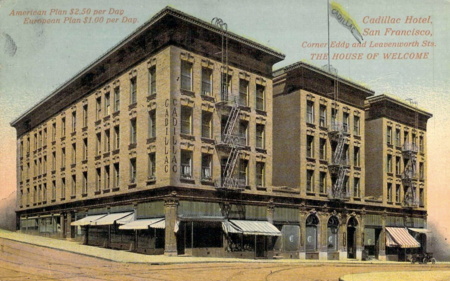Cadillac Hotel (San Francisco, California)

The Cadillac Hotel is a historic building from c. 1907 – c. 1908 in the Tenderloin neighborhood of San Francisco, California, U.S.. It was the first non-profit single-residence occupancy (SRO) hotel in the Western United States. Since 2015, the first two floors of the building is the home to the Tenderloin Museum, a cultural history museum dedicated to the neighborhood. It was called the A.A. Louderback Building, and nicknamed "The House of Welcome" during the early 20th-century.The Cadillac Hotel has been listed as a San Francisco Designated Landmark since 1985; and is part of the NRHP-listed Uptown Tenderloin Historic District since 2009. The building also has a historical marker, erected by Uptown Tenderloin, Inc..
Excerpt from the Wikipedia article Cadillac Hotel (San Francisco, California) (License: CC BY-SA 3.0, Authors, Images).Cadillac Hotel (San Francisco, California)
Eddy Street, San Francisco
Geographical coordinates (GPS) Address Nearby Places Show on map
Geographical coordinates (GPS)
| Latitude | Longitude |
|---|---|
| N 37.783867 ° | E -122.413917 ° |
Address
Hamlin Hotel
Eddy Street 385;387
94102 San Francisco
California, United States
Open on Google Maps






